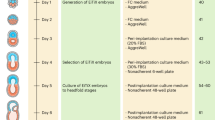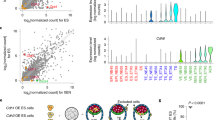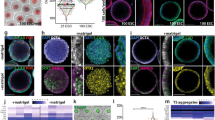Abstract
Mammalian embryogenesis requires the coordination of embryonic and extra-embryonic tissues to enable implantation into the uterus and post-implantation development to establish the body plan. Mouse embryonic stem cells (ESCs) are a useful tool for studying pluripotent embryonic tissue in vitro. However, they cannot undertake correct embryogenesis alone. Many attempts to model the early embryo in vitro involve the aggregation of ESCs into spheroids of variable size and cell number that undertake germ-layer specification but fail to recapitulate the characteristic architecture and arrangement of tissues of the early embryo. Here, we describe a protocol to generate the first embryo-like structures by directing the assembly of mouse ESCs and extra-embryonic trophoblast stem cells (TSCs) in a 3D extracellular matrix (ECM) into structures we call ‘polarized embryo-like structures’. By establishing the medium and culture conditions needed to support the growth of both stem cell types simultaneously, embryonic architecture is generated within 4 d of co-culture. This protocol can be performed by those proficient in standard ESC culture techniques and can be used in developmental studies to investigate the interactions between embryonic and extra-embryonic tissues during mammalian development.
This is a preview of subscription content, access via your institution
Access options
Access Nature and 54 other Nature Portfolio journals
Get Nature+, our best-value online-access subscription
$29.99 / 30 days
cancel any time
Subscribe to this journal
Receive 12 print issues and online access
$259.00 per year
only $21.58 per issue
Buy this article
- Purchase on Springer Link
- Instant access to full article PDF
Prices may be subject to local taxes which are calculated during checkout


Similar content being viewed by others
References
Boroviak, T., Loos, R., Bertone, P., Smith, A. & Nichols, J. The ability of inner-cell-mass cells to self-renew as embryonic stem cells is acquired following epiblast specification. Nat. Cell Biol. 16, 516–28 (2014).
Ying, Q.-L. & Smith, A. G. Defined conditions for neural commitment and differentiation. Methods Enzymol. 365, 327–341 (2003).
Murry, C. E. & Keller, G. Differentiation of embryonic stem cells to clinically relevant populations: lessons from embryonic development. Cell 132, 661–680 (2008).
Irion, S., Nostro, M. C., Kattman, S. J. & Keller, G. M. Directed differentiation of pluripotent stem cells: from developmental biology to therapeutic applications. Cold Spring Harb. Symp. Quant. Biol. 73, 101–110 (2008).
Hattori, N. Cerebral organoids model human brain development and microcephaly. Mov. Disord. 29, 185–185 (2014).
Eiraku, M. et al. Self-organizing optic-cup morphogenesis in three-dimensional culture. Nature 472, 51–6 (2011).
Xia, Y. et al. The generation of kidney organoids by differentiation of human pluripotent cells to ureteric bud progenitor-like cells. Nat. Protoc. 9, 2693–704 (2014).
Takasato, M. et al. Directing human embryonic stem cell differentiation towards a renal lineage generates a self-organizing kidney. Nat. Cell Biol. 16, 118–26 (2014).
Takasato, M., Er, P. X., Chiu, H. S. & Little, M. H. Generation of kidney organoids from human pluripotent stem cells. Nat. Protoc. 11, 1681–1692 (2016).
Meinhardt, A. et al. 3D reconstitution of the patterned neural tube from embryonic stem cells. Stem Cell Rep. 3, 1–13 (2014).
ten Berge, D. et al. Wnt signaling mediates self-organization and axis formation in embryoid bodies. Cell Stem Cell 3, 508–18 (2008).
van den Brink, S. C. et al. Symmetry breaking, germ layer specification and axial organisation in aggregates of mouse embryonic stem cells. Development 141, 4231–42 (2014).
Warmflash, A., Sorre, B., Etoc, F., Siggia, E. D. & Brivanlou, A. H. A method to recapitulate early embryonic spatial patterning in human embryonic stem cells. Nat. Methods 11, 847–854 (2014).
Bedzhov, I. & Zernicka-Goetz, M. Self-organizing properties of mouse pluripotent cells initiate morphogenesis upon implantation. Cell 156, 1032–44 (2014).
Arnold, S. J. & Robertson, E. J. Making a commitment: cell lineage allocation and axis patterning in the early mouse embryo. Nat. Rev. Mol. Cell Biol. 10, 91–103 (2009).
Tanaka, S., Kunath, T., Hadjantonakis, A., Nagy, A. & Rossant, J. Promotion of trophoblast stem cell proliferation by FGF4. Science 282, 2072–2075 (1998).
Harrison, S. E., Sozen, B., Christodoulou, N., Kyprianou, C. & Zernicka-goetz, M. Assembly of embryonic and extra-embryonic stem cells to mimic embryogenesis in vitro. Science https://doi.org/10.1126/science.aal1810 (2017).
Wilkinson, D. G., Bhatt, S. & Herrmann, B. G. Expression of the mouse T gene and its role in mesoderm formation. Nature 343, 657–659 (1990).
Scialdone, A. et al. Resolving early mesoderm diversification through single-cell expression profiling. Nature 535, 289–293 (2016).
Peng, G. et al. Spatial transcriptome for the molecular annotation of lineage fates and cell identity in mid-gastrula mouse embryo. Dev. Cell 36, 681–697 (2016).
Winnier, G., Blessing, M., Labosky, P. A. & Hogan, B. L. M. Bone morphogenetic protein-4 is required for mesoderm formation and patterning in the mouse. Genes Dev. 9, 2105–2116 (1995).
Lawson, K. A. et al. Bmp4 is required for the generation of primordial germ cells in the mouse embryo. Genes Dev. 13, 424–436 (1999).
Kreuter, J. Nanoparticles and microparticles for drug and vaccine delivery. J. Anat. 189, 503–505 (1996).
Kunath, T. et al. Imprinted X-inactivation in extra-embryonic endoderm cell lines from mouse blastocysts. Development 132, 1649–1661 (2005).
Brown, K. et al. Extraembryonic endoderm (XEN) stem cells producefactors that activate heart formation. PLoS ONE 5, e13446 (2010).
Paca, A. et al. BMP signaling induces visceral endoderm differentiation of XEN cells and parietal endoderm. Dev. Biol. 361, 90–102 (2012).
Artus, J. et al. BMP4 signaling directs primitive endoderm-derived XEN cells to an extraembryonic visceral endoderm identity. Dev. Biol. 361, 245–262 (2012).
Ying, Q. et al. The ground state of embryonic stem cell self-renewal. Nature 453, 519–24 (2008).
Morris, Sa et al. Dynamics of anterior-posterior axis formation in the developing mouse embryo. Nat. Commun. 3, 673 (2012).
Bedzhov, I., Leung, C. Y., Bialecka, M. & Zernicka-Goetz, M. In vitro culture of mouse blastocysts beyond the implantation stages. Nat. Protoc. 9, 2732–2739 (2014).
Fehling, H. J. et al. Tracking mesoderm induction and its specification to the hemangioblast during embryonic stem cell differentiation. Development 130, 4217–4227 (2003).
Payer, B. et al. Generation of stella-GFP transgenic mice: a novel tool to study germ cell development. Genesis 44, 75–83 (2006).
Rhee, J. M. et al. In vivo imaging and differential localization of lipid-modified GFP-variant fusions in embryonic stem cells and mice. Genesis 44, 202–218 (2006).
Behringer, R., Gertsenstein, M., Nagy, K. V. & Nagy, A. Manipulating the Mouse Embryo: A Laboratory Manual 4th edn. (Cold Spring Harbor Laboratory Press, 2014).
Lee, G. Y., Kenny, Pa, Lee, E. H. & Bissell, M. J. Three-dimensional culture models of normal and malignant breast epithelial cells. Nat. Methods 4, 359–65 (2007).
Nagy, A., Gertsenstein, M., Vintersten, K. & Behringer, R. Preparing feeder cell layers from STO or mouse embryo fibroblast (MEF) cells: treatment with mitomycin C. CSH Protoc. (2006). https://doi.org/10.1101/pdb.prot4399
Tanaka, S. Derivation and culture of mouse trophoblast stem cells in vitro. Methods Mol. Biol. 329, 35–44 (2006).
Rossant, J. Culturing trophoblast stem (TS) cell lines. CSH Protoc.. https://doi.org/10.1101/pdb.prot4406 (2006).
Kubaczka, C. et al. Derivation and maintenance of murine trophoblast stem cells under defined conditions. Stem Cell Rep. 2, 232–242 (2014).
Ohinata, Y. & Tsukiyama, T. Establishment of trophoblast stem cells under defined culture conditions in mice. PLoS ONE 9, e107308 (2014).
Acknowledgements
We are grateful to our colleagues in the M.Z.-G. group and to M. Huch for advice. We are grateful to the Wellcome Trust for the Senior Research fellowship (grant no. 098287/Z/12/Z) and for a European Research Council grant (code: 669198) awarded to M.Z.-G. to fund this work. We are also grateful for the BBSRC DTP studentship that supports S.E.H. and to the Scientific and Technological Research Council of Turkey, which supports B.S.’
Author information
Authors and Affiliations
Contributions
S.E.H., B.S., and M.Z.-G. designed the protocol, carried out the work, analyzed the results, and prepared the manuscript.
Corresponding author
Ethics declarations
Competing interests
M.Z.-G. and S.E.H. declare that they are inventors on a patent application (1615343.9) submitted by Cell Guidance Systems (in which the University of Cambridge and the Wellcome Trust are beneficiaries) that covers the method and medium composition used to generate stem cell–derived embryos. B.S. declares no competing interests.
Additional information
Publisher’s note: Springer Nature remains neutral with regard to jurisdictional claims in published maps and institutional affiliations.
Related links
1. Assembly of embryonic and extraembryonic stem cells to mimic embryogenesis in vitro: https://doi.org/10.1126/science.aal1810.
2. Self-organizing properties of mouse pluripotent cells initiate morphogenesis upon implantation: https://doi.org/10.1016/j.cell.2014.01.023.
Supplementary information
Supplementary Text and Figures
Supplementary Table 1
Rights and permissions
About this article
Cite this article
Harrison, S.E., Sozen, B. & Zernicka-Goetz, M. In vitro generation of mouse polarized embryo-like structures from embryonic and trophoblast stem cells. Nat Protoc 13, 1586–1602 (2018). https://doi.org/10.1038/s41596-018-0005-x
Published:
Issue Date:
DOI: https://doi.org/10.1038/s41596-018-0005-x
This article is cited by
-
Assembly of complete mouse embryo models from embryonic and induced stem cell types in vitro
Nature Protocols (2023)
-
Periodic formation of epithelial somites from human pluripotent stem cells
Nature Communications (2022)
-
Embryotoxic effects of tribromophenol on early post-implantation development of mouse embryos in vitro
Environmental Science and Pollution Research (2022)
-
A novel “embryo-endometrial” adhesion model can potentially predict “receptive” or “non-receptive” endometrium
Journal of Assisted Reproduction and Genetics (2020)
Comments
By submitting a comment you agree to abide by our Terms and Community Guidelines. If you find something abusive or that does not comply with our terms or guidelines please flag it as inappropriate.



